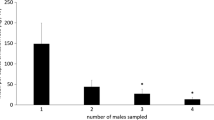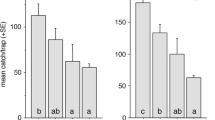Abstract
A piezoelectric sprayer for dispensing semiochemicals was developed and used for a field test of bark beetle semiochemicals. The sprayer consists of a geared pump that pushes a syringe slowly to dispense semiochemicals in solvents through a microtube to a glass micropipet fixed to a piezoelectric high-frequency vibrator. The frequency is adjusted via a function generator to about 120 kHz until the harmonic properties of the glass micropipet, drawn by an electrophysiological pipet puller, cause vibrations that atomize the solvent from the micropipet tip. The sprayer, syringe, pump, function generator, and power supply were hung on one arm of a rotating trap pair (traps 6 m apart) that was slowly rotated at 2 revolutions per hour (rph) to even out the position effects on trap catches. The aggregation pheromone components of Pityogenes bidentatus, grandisol and cis-verbenol, were released by standard tube dispensers in one trap and compared to the release of similar amounts by the sprayer in the other trap. No significant differences in catch were observed. No effect of the solvent hexane on aggregation could be observed. The trap pair also caught approximately equal numbers of bark beetles when the baits were identical. The release of (+)and (−)-α-pinene, (+)-3-carene, and terpinolene, monoterpenes of host Scotch pine, Pinus sylvestris, at increasing rates from 0.01 to 10 log-equivalents in decadic steps (each at 0.1–100 μg/min) resulted in decreasing responses to aggregation pheromone (only 9% at highest rate). Inhibition by the individual monoterpenes tested at the 100 μg/min rate was significant for (+)and (−)-α-pinene and terpinolene (12, 13, and 15% of control, respectively). The inhibition by the host Scotch pine monoterpenes may allow P. bidentatus to avoid resistant trees that release large amounts of toxic monoterpenes in their resin and instead colonize dying and diseased limbs or slash, the usual host substrate. The piezoelectric sprayer should prove generally useful to dispense precise amounts of semiochemicals in field and laboratory experiments.
Similar content being viewed by others
REFERENCES
Bakke, A. 1981. Inhibition of the response in Ips typographus to the aggregation pheromone; field evaluation of verbenone and ipsenol. Z. Angew. Entomol. 92:172–177.
Bakke, A., FrØyen, P., and SKATTEBØL, L. 1977. Field response to a new pheromonal compound isolated from Ips typographus. Naturwissenschaften 64:98.
Bedard, W. D., Tilden, P. E., Wood, D. L., Silverstein, R. M., Brownlee, R. G., and Rodin, J. O. 1969. Western pine beetle: Field response to its sex pheromone and a synergistic host terpene, myrcene. Science 164:1284–1285.
Bordasch, R. P., and Berryman, A. A. 1977. Host resistance to the fir engraver beetle, Scolytus ventralis (Coleoptera: Scolytidae) 2. Repellency of Abies grandis resins and some monoterpenes. Can. Entomol. 109:95–100.
Browne, L. E., Birch, M. C., and Wood, D. L. 1974. Novel trapping and delivery systems for airborne insect pheromones. J. Insect. Physiol. 20:183–193.
Byers, J. A. 1981. Pheromone biosynthesis in the bark beetle, Ips paraconfusus, during feeding or exposure to vapours of host plant precursors. Insect Biochem. 11:563–569.
Byers, J. A. 1988. Novel diffusion-dilution method for release of semiochemicals: Testing pheromone component ratios on western pine beetle. J. Chem. Ecol. 14:199–212.
Byers, J. A. 1989. Chemical ecology of bark beetles. Experientia 45:271–283.
Byers, J. A. 1992. Attraction of bark beetles, Tomicus piniperda, Hylurgops palliatus, and Trypodendron domesticum and other insects to short-chain alcohols and monoterpenes. J. Chem. Ecol. 18:2385–2402.
Byers, J. A., and Birgersson, G. 1990. Pheromone production in a bark beetle independent of myrcene precursor in host pine species. Naturwissenschaften 77:385–387.
Byers, J. A., Lanne, B. S., LÖfqvist, J., Schlyter, F., and BergstrÖm, G. 1985. Olfactory recognition of host-tree susceptibility by pine shoot beetles. Naturwissenschaften 72:324–326.
Byers, J. A., Birgersson, G., LÖfqvist, J., and BergstrÖm, G. 1988. Synergistic pheromones and monoterpenes enable aggregation and host recognition by a bark beetle, Pityogenes chalcographus. Naturwissenschaften 75:153–155.
Byers, J. A., Schlyter, F., Birgersson, G., and Francke, W. 1990. (E)-Myrcenol in Ips duplica tus: An aggregation pheromone component new for bark beetles. Experientia 46:1209–1211.
Byers, J. A., Zhang, Q. H., Schlyter, F., and Birgersson, G. 1998. Volatiles from nonhost birch trees inhibit pheromone response in spruce bark beetles. Naturwissenschaften 85:557–561.
El-sayed, A., GÖdde, J., and Arn, H. 1999a. Sprayer for quantitative application of odor stimuli. Environ. Entomol. 28:947–953.
El-sayed, A., GÖdde, J., Witzgall, P., and Arn, H. 1999b. Characterization of pheromone blend for grapevine moth, Lobesia botrana, by using flight track recording. J. Chem. Ecol. 25:389–400.
Hendry, L. B., Piatek, B., Browne, L. E., Wood, D. L., Byers, J. A., Fish, R. H., and Hicks, R. A. 1980. In vivo conversion of a labelled host plant chemical to pheromones of the bark beetle Ips paraconfusus. Nature 284:485.
Hodges, J. D., Elam, W. W., Watson, W. R., and Nebeker, T. E. 1979. Oleoresin characteristics and susceptibility of four southern pines to southern pine beetle (Coleoptera: Scolytidae) attacks. Can. Entomol. 111:889–896.
Hughes, P. R. 1974. Myrcene: A precursor of pheromones in Ips beetles. J. Insect Physiol. 20:1271–1275.
Ivarsson, P., Schlyter, F., and Birgersson, G. 1993. Demonstration of de novo pheromone biosynthesis in Ips duplicatus (Coleoptera: Scolytidae): Inhibition of ipsdienol and (E)-myrcenol production by compactin. Insect Biochem. Mol. Biol. 23:655–662.
Klepzig, K. D., Smalley, E. B., and Raffa, K. F. 1996. Combined chemical defenses against an insect-fungal complex. J. Chem. Ecol. 22:1367–1388.
Klimetzek, D., and Francke, W. 1980. Relationship between the enantiomeric composition of a-pinene in host trees and the production of verbenols in Ips species. Experientia 36:1343–1345.
Lekander, B., Bejer-peterson, B., Kangas, E., and Bakke, A. 1977. The distribution of bark beetles in the Nordic countries. Acta Entomol. Fenn. 32:1–36.
LindelÖw, Å, Risberg, B., and SjÖdin, K. 1992. Attraction during flight of scolytids and other bark and wood-dwelling beetles to volatiles from fresh and stored spruce wood. Can. J. For. Res. 22:224–228.
Phillips, T. W., Wilkening, A. J., Atkinson, T. H., Nation, J. L., Wilkinson, R. C., and Foltz, J. L. 1988. Synergism of turpentine and ethanol as attractants for certain pine-infesting beetles (Coleoptera). Environ. Entomol. 17:456–462.
Pitman, G. B., Renwick, J. A. A., and VitÉ, J. P. 1966. Studies on the pheromone of Ips confusus (LeConte). IV. Isolation of the attractive substance by gas-liquid chromatography. Contrib. Boyce Thompson Inst. 23:243–250.
Raffa, K. F., and Berryman, A. A. 1982. Accumulation of monoterpenes and associated volatiles following inoculation of grand fir with a fungus transmitted by the fir engraver Scolytus ventralis (Coleoptera: Scolytidae). Can. Entomol. 114:797–810.
Raffa, K. F., and Berryman, A. A. 1987. Interacting selective pressures in conifer-bark beetle systems a basis for reciprocal adaptations. Am. Nat. 129:234–262.
Reddemann, J., and Schopf, R. 1996. The importance of monoterpenes in the aggregation of the spruce bark beetle Ips typographus (Coleoptera: Scolytidae: Ipinae). Entomol. Gen. 21:69–80.
Renwick, J. A. A., Hughes, P. R., and Krull, I. S. 1976. Selective production of cis-and transverbenol from (-)-and (+)-a-pinene by a bark beetle. Science 191:199–201.
Rudinsky, J. A., Novak, V., and Svihra, P. 1971. Attraction of the bark beetle Ips typographus L. to terpenes and a male-produced pheromone. Z. Angew. Entomol. 67:179–188.
Rudinsky, J. A., Furniss, M. M., Kline, L. N., and Schmitz, R. F. 1972. Attraction and repression of Dendroctonus pseudotsugae (Coleoptera: Scolytidae) by three synthetic pheromones in traps in Oregon and Idaho. Can. Entomol. 104:815–822.
Schlyter, F., Birgersson, G., Byers, J. A., LÖfqvist, J., and BergstrÖm, G. 1987. Field response of the spruce bark beetle, Ips typographus, to aggregation pheromone candidates. J. Chem. Ecol. 13:701–716.
Seybold, S. J., Quilici, D. R., Tillman, J. A., Vanderwel, D., Wood, D. L., and Blomquist, G. J. 1995. De novo biosynthesis of the aggregation pheromone components ipsenol and ipsdienol by the pine bark beetles Ips paraconfusus Lanier and Ips pini (Say) (Coleoptera: Scolytidae). Proc. Natl. Acad. Sci. U.S.A. 92:8393–8397.
Smith, R. H. 1961. The fumigant toxicity of three pine resins to Dendroctonus brevicomis and D. jeffrei. J. Econ. Entomol. 54:365–369.
Smith, R. H. 1965. A physiological difference among beetles of Dendroctonus ponderosae (cD. monticolae) and D. ponderosae (cD. jeffreyi). Ann. Entomol. Soc. Am. 58:440–442.
Webb, J. L. 1906. The western pine destroying bark beetle. U.S. Department of Agriculture Bureau of Entomology Bulletin 58, Pt. II. USDA, Washington, D.C. 30 pp.
Werner, R. A. 1972. Response of the beetle, Ips grandicolis, to combinations of host and insect produced attractants. J. Insect Physiol. 18:1405–1412.
Werner, R. A. 1995. Toxicity and repellency of 4-allylanisole and monoterpenes from white spruce and tamarack to the spruce beetle and eastern larch beetle (Coleoptera: Scolytidae). Environ. Entomol. 24:372–379.
Author information
Authors and Affiliations
Rights and permissions
About this article
Cite this article
El-Sayed, A.M., Byers, J.A. Inhibitory Effect of Monoterpenes on Response of Pityogenes bidentatus to Aggregation Pheromone Released by Piezoelectric Sprayer for Precision Release of Semiochemicals. J Chem Ecol 26, 1795–1809 (2000). https://doi.org/10.1023/A:1005536421703
Issue Date:
DOI: https://doi.org/10.1023/A:1005536421703




